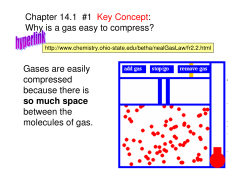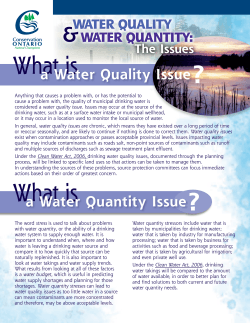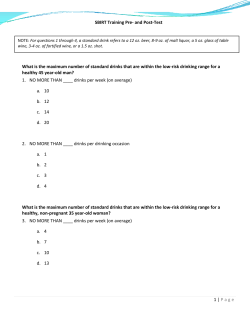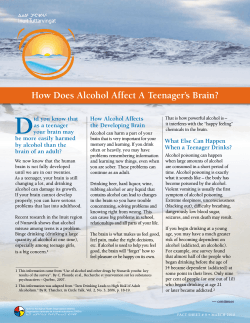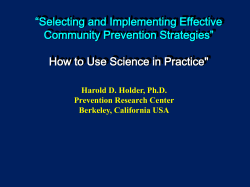
Interpreting Test Results
Interpreting Test Results Related Water Quality Titles The laboratory will send a written copy of your water test results. When you receive the results, Understanding Your Water Test Report, MF-912, and Organic and Radiologic Chemicals in Drinking Water, MF-1142, will help you interpret them. If your report shows an unacceptable contamination level and you have questions about what to do, contact one of the sources below. Confirmation testing is always recommended before taking expensive or drastic corrective measures. Establishing a record with several tests over at least a year is recommended before implementing treatment. Available from Local Extension Offices: For further information contact: • Local Health Department office, • Private Wells — Safe Location and Construction, MF-970 • Private Well Maintenance and Protection, MF-2396 • Shock Clorination for Disinfecting Water Systems, MF-911 Note: All titles shown in italics are K-State Research and Extension publications. Available from Extension Biological and Agricultural Engineering, 237 Seaton Hall, KSU, Manhattan, Kansas 66506: • County Cooperative Extension office, • Private Drinking Water Supplies NRAES 47 • Kansas Department of Health and Environment, District offices, or • Private Water System Handbook, 4th Edition, Midwest Planning Service14 • EPA Safe Drinking Water Hotline a national toll-free number (800-426-4791). • Private Water Wells section of Environmental Health Handbook • National Drinking Water Clearinghouse (800-624-8301) Test Records Compare new test results with previous results to identify a trend or an unknown problem. File test reports where you can find them. Private Water Well—Owner/Operator Manual, MF-2409, is a convenient file. Water test records often are needed for property sales. Good records help support damage claims from chemical spills, leaks, or poor management. “Safe drinking water cannot be taken for granted. It does not happen by accident. Safe drinking water comes from safe wells. Safe wells result from thoughtful design, careful construction, meticulous management and annual maintenance.” Publications from Kansas State University are available on the World Wide Web at: http://www.oznet.ksu.edu Contents of this publication may be freely reproduced for educational purposes. All other rights reserved. In each case, credit G. Morgan Powell, Barbara L. Dallemand, Judith M. Willingham, Taking a Water Sample, Kansas State University, March, 2000. Kansas State University Agricultural Experiment Station and Cooperative Extension Service MF- 963 TAKING A WATER SAMPLE March 2000 It is the policy of Kansas State University Agricultural Experiment Station and Cooperative Extension Service that all persons shall have equal opportunity and access to its educational programs, services, activities, and materials without regard to race, color, religion, national origin, sex, age or disability. Kansas State University is an equal opportunity organization. Issued in furtherance of Cooperative Extension Work, Acts of May 8 and June 30, 1914, as amended. Kansas State University, County Extension Councils, Extension Districts, and United States Department of Agriculture Cooperating, Marc A. Johnson, Director. G. Morgan Powell Extension Engineer, Water Quality Barbara L. Dallemand Assistant Extension Engineer, Onsite Wastewater Judith M. Willingham Extension Associate, Food*A*Syst Just because water appears clear and tastes good does not mean it is safe to drink. Most contaminants that affect health are not detected by our senses. A 1994 survey of private wells used for drinking water in Kansas found that only 40 percent met safe drinking water standards. Safe wells are the best assurance for safe drinking water. If your water comes from a private well, well location out of the pathways of contaminants, well construction that meets current standards, site management to protect well from contamination, and annual well maintenance are essential for a safe well. Water testing is an essential part of annual well maintenance. Water testing may be done for several reasons as discussed in K-State Research and Extension publication, Recommended Water Tests for Private Wells, MF-871. We also recommend you consult with your local health department, county Extension office, or other adviser to decide what tests are needed and how often to sample. After selecting the tests, choose a laboratory (transportation to the laboratory is often an important factor) and get sample containers from the laboratory. Unless contacts have been made before, it is wise to contact two or more laboratories for information. Testing to Help Ensure Safe Drinking Water, MF-951, lists laboratories in Kansas and nearby states certified for drinking water tests. Analytical results from the most meticulous laboratory are no better than sample collection and handling. Always follow sampling, care, and shipping instructions from the laboratory. Guidelines in this brochure will help insure good sample collection. If you have questions, contact the laboratory for clarification. General Procedures Procedures for taking a water sample differ, depending on what is being tested. However, cleanliness and care are always important when collecting any water sample. Contaminants are easily introduced, so care must be taken to prevent anything but the water sample from contacting the container opening, the inside of the container, or the cap. Any contamination means the test results will be inaccurate. Timeliness in collecting the sample and delivering it to the laboratory for analysis is also important. Some contaminants deteriorate or change with time. Use only the proper laboratory sample container for the test desired. Laboratories often only accept samples received in their containers. Complete the forms included with the sample container to assure accurate processing, recording, and reporting. For most water tests—including coliform bacteria, nitrate and other inorganics—follow these guidelines when collecting a sample (note exceptions): • Wash your hands with soap and water and dry with a clean paper towel. • Select a faucet that is used regularly and does not leak, preferably one inside the house. A swinging spout is not recommended because of possible contamination at the joint. Do not use a garden, frost-free hydrant. 1. Remove the aerator. 2. Disinfect the faucet using heat or rubbing alcohol. • Do not sample from a source connected to any treatment device such as water softener or filter, as this may be the source of contamination. • Do not rinse the sample container as it may contain preservatives to protect sample. • Read and follow sampling procedures exactly (in laboratory instructions or this brochure). Transport the sample as instructed by the laboratory (shipping in a cooler or insulated container may be required). • Protect sample from heat and freezing. • Deliver or send the sample so that it arrives at the laboratory by Wednesday and within 24 hours of collection. Avoid sending Monday and the day after a a holiday because of possible shipping delays. Sampling for Total or Fecal (Ecoli) Coliform Bacteria Because bacteria are living organisms, accurate tests depend on preventing contamination during sample collection and protecting the sample after collection. Guidelines: • Remove faucet aerator, being careful not to touch the inside of the spout. If water drains from the faucet leaving it dry or the faucet is not used regularly, disinfect it using heat or 3. Run the water at least 4. Fill the bottle without 5 minutes. touching inside of the bottle or lid. rubbing alcohol. Use a cotton ball to swab alcohol over the water outlet and interior surfaces of the faucet. Do not use heat on plastic faucets. • After clearing the line by running water for at least 5 minutes, reduce water flow to a clear stream with no bubbles and run at least 2 minutes more. • With the water flowing, hold the sample container in one hand and remove the cap with the other hand. Then move the container into and out of the running stream without turning the faucet on and off. Fill to the neck of bottle or fill line. • Do not touch the opening or any interior part of the sample container or cap. Do not set the cap down. • Immediately replace cap and tighten securely. • Protect the sample from sunlight and keep it cool but do not freeze. • Be sure sample arrives at the laboratory within 24 hours of collection. Sampling for Lead or Copper Because lead and copper may be leached from plumbing systems when water stands in the lines, it is important to follow these procedures: • Do not run water for at least 8 hours before collecting this sample. Turn the faucet on and fill the sample container with the first flow from the faucet. • Do not rinse sample container. • Replace lid and tighten securely. Sampling for Synthetic Organic Chemicals (SOCs) Sampling SOCs, including most pesticides, requires special procedures so samples will not deteriorate or become contaminated before reaching the laboratory. Contact the laboratory for complete instructions and a collection kit. • Collect the sample only in the colored bottle provided. The dark glass prevents light from degrading the sample. Be sure to fill the bottle following the directions. • Cap the bottle only with the Teflon coated lid. The special lid prevents false positive results caused by certain plastics. • Keep the sample refrigerated, preferably 35° to 38°F, and deliver or mail so it arrives at the laboratory within 24 hours. When shipping the sample, pack it in ice and ship in an isulated container. Sampling for Volatile Organic Chemicals (VOCs) Sampling for VOCs or solvents requires these specific procedures so volatile contaminants are not lost in collection and transit: • Use special sample bottle and carefully follow instructions supplied by the laboratory. • After clearing the line by running water for at least 5 minutes, reduce water flow to a clear stream with no bubbles. Fill the bottle completely so there is no air space when lid is installed. • Immediately seal the container so the volatile material is not lost. General Procedures Procedures for taking a water sample differ, depending on what is being tested. However, cleanliness and care are always important when collecting any water sample. Contaminants are easily introduced, so care must be taken to prevent anything but the water sample from contacting the container opening, the inside of the container, or the cap. Any contamination means the test results will be inaccurate. Timeliness in collecting the sample and delivering it to the laboratory for analysis is also important. Some contaminants deteriorate or change with time. Use only the proper laboratory sample container for the test desired. Laboratories often only accept samples received in their containers. Complete the forms included with the sample container to assure accurate processing, recording, and reporting. For most water tests—including coliform bacteria, nitrate and other inorganics—follow these guidelines when collecting a sample (note exceptions): • Wash your hands with soap and water and dry with a clean paper towel. • Select a faucet that is used regularly and does not leak, preferably one inside the house. A swinging spout is not recommended because of possible contamination at the joint. Do not use a garden, frost-free hydrant. 1. Remove the aerator. 2. Disinfect the faucet using heat or rubbing alcohol. • Do not sample from a source connected to any treatment device such as water softener or filter, as this may be the source of contamination. • Do not rinse the sample container as it may contain preservatives to protect sample. • Read and follow sampling procedures exactly (in laboratory instructions or this brochure). Transport the sample as instructed by the laboratory (shipping in a cooler or insulated container may be required). • Protect sample from heat and freezing. • Deliver or send the sample so that it arrives at the laboratory by Wednesday and within 24 hours of collection. Avoid sending Monday and the day after a a holiday because of possible shipping delays. Sampling for Total or Fecal (Ecoli) Coliform Bacteria Because bacteria are living organisms, accurate tests depend on preventing contamination during sample collection and protecting the sample after collection. Guidelines: • Remove faucet aerator, being careful not to touch the inside of the spout. If water drains from the faucet leaving it dry or the faucet is not used regularly, disinfect it using heat or 3. Run the water at least 4. Fill the bottle without 5 minutes. touching inside of the bottle or lid. rubbing alcohol. Use a cotton ball to swab alcohol over the water outlet and interior surfaces of the faucet. Do not use heat on plastic faucets. • After clearing the line by running water for at least 5 minutes, reduce water flow to a clear stream with no bubbles and run at least 2 minutes more. • With the water flowing, hold the sample container in one hand and remove the cap with the other hand. Then move the container into and out of the running stream without turning the faucet on and off. Fill to the neck of bottle or fill line. • Do not touch the opening or any interior part of the sample container or cap. Do not set the cap down. • Immediately replace cap and tighten securely. • Protect the sample from sunlight and keep it cool but do not freeze. • Be sure sample arrives at the laboratory within 24 hours of collection. Sampling for Lead or Copper Because lead and copper may be leached from plumbing systems when water stands in the lines, it is important to follow these procedures: • Do not run water for at least 8 hours before collecting this sample. Turn the faucet on and fill the sample container with the first flow from the faucet. • Do not rinse sample container. • Replace lid and tighten securely. Sampling for Synthetic Organic Chemicals (SOCs) Sampling SOCs, including most pesticides, requires special procedures so samples will not deteriorate or become contaminated before reaching the laboratory. Contact the laboratory for complete instructions and a collection kit. • Collect the sample only in the colored bottle provided. The dark glass prevents light from degrading the sample. Be sure to fill the bottle following the directions. • Cap the bottle only with the Teflon coated lid. The special lid prevents false positive results caused by certain plastics. • Keep the sample refrigerated, preferably 35° to 38°F, and deliver or mail so it arrives at the laboratory within 24 hours. When shipping the sample, pack it in ice and ship in an isulated container. Sampling for Volatile Organic Chemicals (VOCs) Sampling for VOCs or solvents requires these specific procedures so volatile contaminants are not lost in collection and transit: • Use special sample bottle and carefully follow instructions supplied by the laboratory. • After clearing the line by running water for at least 5 minutes, reduce water flow to a clear stream with no bubbles. Fill the bottle completely so there is no air space when lid is installed. • Immediately seal the container so the volatile material is not lost. Interpreting Test Results Related Water Quality Titles The laboratory will send a written copy of your water test results. When you receive the results, Understanding Your Water Test Report, MF-912, and Organic and Radiological Chemicals in Drinking Water, MF-1142, will help you interpret them. If your report shows an unacceptable contamination level and you have questions about what to do, contact one of the sources below. Confirmation testing is always recommended before taking expensive or drastic corrective measures. Establishing a record with several tests over at least a year is recommended before implementing treatment. Available from Local Extension Offices: For further information contact: • Local Health Department office, • Private Wells — Safe Location and Construction, MF-970 • Private Well Maintenance and Protection, MF-2396 • Shock Chlorination for Disinfecting Water Systems, MF-911 Note: All titles shown in italics are K-State Research and Extension publications. Available from Extension Biological and Agricultural Engineering, 237 Seaton Hall, KSU, Manhattan, Kansas 66506: • County Cooperative Extension office, • Private Drinking Water Supplies NRAES 47 • Kansas Department of Health and Environment, District offices, or • Private Water System Handbook, 4th Edition, Midwest Planning Service14 • EPA Safe Drinking Water Hotline a national toll-free number (800-426-4791). • Private Water Wells section of Environmental Health Handbook • National Drinking Water Clearinghouse (800-624-8301) Test Records Compare new test results with previous results to identify a trend or an unknown problem. File test reports where you can find them. Private Water Well—Owner/Operator Manual, MF-2409, is a convenient file. Water test records often are needed for property sales. Good records help support damage claims from chemical spills, leaks, or poor management. “Safe drinking water cannot be taken for granted. It does not happen by accident. Safe drinking water comes from safe wells. Safe wells result from thoughtful design, careful construction, meticulous management and annual maintenance.” Publications from Kansas State University are available on the World Wide Web at: http://www.oznet.ksu.edu Contents of this publication may be freely reproduced for educational purposes. All other rights reserved. In each case, credit G. Morgan Powell, Barbara L. Dallemand, Judith M. Willingham, Taking a Water Sample, Kansas State University, March, 2000. Kansas State University Agricultural Experiment Station and Cooperative Extension Service MF- 963 TAKING A WATER SAMPLE March 2000 It is the policy of Kansas State University Agricultural Experiment Station and Cooperative Extension Service that all persons shall have equal opportunity and access to its educational programs, services, activities, and materials without regard to race, color, religion, national origin, sex, age or disability. Kansas State University is an equal opportunity organization. Issued in furtherance of Cooperative Extension Work, Acts of May 8 and June 30, 1914, as amended. Kansas State University, County Extension Councils, Extension Districts, and United States Department of Agriculture Cooperating, Marc A. Johnson, Director. G. Morgan Powell Extension Engineer, Water Quality Barbara L. Dallemand Assistant Extension Engineer, Onsite Wastewater Judith M. Willingham Extension Associate, Food*A*Syst Just because water appears clear and tastes good does not mean it is safe to drink. Most contaminants that affect health are not detected by our senses. A 1994 survey of private wells used for drinking water in Kansas found that only 40 percent met safe drinking water standards. Safe wells are the best assurance for safe drinking water. If your water comes from a private well, well location out of the pathways of contaminants, well construction that meets current standards, site management to protect well from contamination, and annual well maintenance are essential for a safe well. Water testing is an essential part of annual well maintenance. Water testing may be done for several reasons as discussed in K-State Research and Extension publication, Recommended Water Tests for Private Wells, MF-871. We also recommend you consult with your local health department, county Extension office, or other adviser to decide what tests are needed and how often to sample. After selecting the tests, choose a laboratory (transportation to the laboratory is often an important factor) and get sample containers from the laboratory. Unless contacts have been made before, it is wise to contact two or more laboratories for information. Testing to Help Ensure Safe Drinking Water, MF-951, lists laboratories in Kansas and nearby states certified for drinking water tests. Analytical results from the most meticulous laboratory are no better than sample collection and handling. Always follow sampling, care, and shipping instructions from the laboratory. Guidelines in this brochure will help insure good sample collection. If you have questions, contact the laboratory for clarification.
© Copyright 2025
